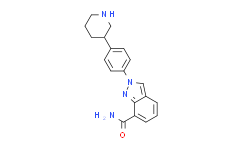| Cas No.: | 1038915-60-4 |
| Chemical Name: | Niraparib free base |
| Synonyms: | (S)-2-(4-(Piperidin-3-yl)phenyl)-2H-indazole-7-carboxamide;MK4827;MK-4827 (Niraparib);(S)-2-(4-(piperidin-3-yl)phenyl)-2Hindazole-7-carboxamide;2-[4-[(3S)-piperidin-3-yl]phenyl]indazole-7-carboxamide;MK-4827;Niraparib;2-{4-[(3R)-piperidin-3-yl]phenyl}-2H-indazole-7-carboxamide;2-{4-[(3S)-piperidin-3-yl]phenyl}-2H-indazole-7-carboxamide;4-Quinolinamine;7-chloro-N-[(3-chlorophenyl)[4-(1-pyrrolidinylmethyl)phenyl]methyl]-;CHEMBL1094636;Niraparib (USAN);Niraparib [USAN];pound notMK4827 pound not MK 4827;2-[4-((3S)-3-Piperidinyl)phenyl]-2H-indazole-7-carboxamide;EOS-60867;MK4827 (Niraparib);Niraparib (MK-4827);2-[4-(3S)piperidin-3-ylphenyl]-2H-indazol-7-carboxamide;2H-Indazole-7-carboxamide, 2-[4-(3S)-3-piperidinylphenyl]-;MK-4827,(S)-2-(4-(piperidin-3-yl)phenyl)-2H-indazole-7-carboxaMide;(S)-2-(4-(piperidin-3-yl)phenyl)-2H-indazole-7-carboxamide hydrocholoride;ZEJULA;HMC2H89N35;MK 4827;Niraparib [USAN:INN];2-{4-[(3S)-piperidin-3-yl]phenyl}indazole-7-carboxamide;MK 4827 (Base);Zejula (TN);GTPL8275;M |
| SMILES: | O=C(C1=C([H])C([H])=C([H])C2C1=NN(C=2[H])C1C([H])=C([H])C(=C([H])C=1[H])[C@@]1([H])C([H])([H])N([H])C([H])([H])C([H])([H])C1([H])[H])N([H])[H] |
| Formula: | C19H20N4O |
| M.Wt: | 320.4 |
| Sotrage: | 2 years -20°C Powder, 2 weeks 4°C in DMSO, 6 months -80°C in DMSO |
| Description: | Niraparib (MK-4827) is a highly potent PARP1 and PARP2 inhibitor with IC50s of 3.8 and 2.1 nM, respectively. |
| In Vivo: | Niraparib (MK-4827) is well tolerated and demonstrates efficacy as a single agent in a xenograft model of BRCA-1 deficient cancer. Niraparib (MK-4827) is well tolerated in vivo and demonstrates efficacy as a single agent in a xenograft model of BRCA-1 deficient cancer. Niraparib (MK-4827) is characterized by acceptable pharmacokinetics in rats with plasma clearance of 28 (mL/min)/kg, very high volume of distribution (Vdss=6.9 L/kg), long terminal half-life (t1/2=3.4 h), and excellent bioavailability, F=65%[1]. Niraparib (MK-4827) enhances radiation response of p53 mutant Calu-6 tumor in both cases, with the single daily dose of 50 mg/kg being more effective than 25 mg/kg given twice daily[3]. |
| In Vitro: | Niraparib (MK-4827) inhibits PARP activity with EC50=4 nM and EC90=45 nM in a whole cell assay. MK-4827 inhibits proliferation of cancer cells with mutant BRCA-1 and BRCA-2 with CC50 in the 10-100 nM range. MK-4827 displays excellent PARP 1 and 2 inhibition with IC50=3.8 and 2.1 nM, respectively, and in a whole cell assay[1]. To validate that Niraparib (MK-4827) inhibits PARP in these cell lines, A549 and H1299 cells are treated with 1 μM MK-4827 for various times and measured PARP enzymatic activity using a chemiluminescent assay. The results show that Niraparib (MK-4827) inhibits PARP within 15 minutes of treatment reaching about 85% inhibition in the A549 cells at 1 h and about 55% inhibition at 1 h for the H1299 cells[2]. |






















